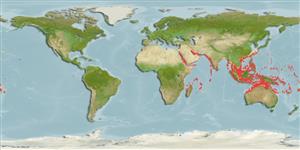Common names from other countries
Environment: milieu / climate zone / depth range / distribution range
Ecologia
marinhas associadas(os) a recifes; intervalo de profundidade 25 - 147 m (Ref. 5222). Tropical; 30°N - 22°S, 32°E - 173°W (Ref. 5222)
Indo-Pacific: Red Sea, Zanzibar, Maldives, St. Brandon's Shoals, Sri Lanka, Chagos, Nazareth Bank, Sumatra, and Fiji. Recently recorded from Tonga (Ref. 53797). Subspecies, Plectropomus pessuliferus marisburi occurs in the Red Sea, while Plectropomus pessuliferus pessuliferus from the rest of the Indo-Pacific region (Ref. 3150). Often misidentified as Plectropomus maculatus.
Length at first maturity / Tamanho / Peso / Idade
Maturity: Lm ?, range 63 - ? cm
Max length : 120 cm TL macho/indeterminado; (Ref. 5222)
Espinhos dorsais (total) : 7 - 8; Raios dorsais moles (total) : 10 - 12; Espinhos anais: 3; Raios anais moles: 8.
An uncommon species (Ref. 9710) found in shallow lagoon and seaward reefs. In the Hong Kong live fish markets (Ref. 27253). Solitary (Ref 90102).
Life cycle and mating behavior
Maturities | Reprodução | Spawnings | Egg(s) | Fecundities | Larvas
Heemstra, P.C. and J.E. Randall, 1993. FAO Species Catalogue. Vol. 16. Groupers of the world (family Serranidae, subfamily Epinephelinae). An annotated and illustrated catalogue of the grouper, rockcod, hind, coral grouper and lyretail species known to date. Rome: FAO. FAO Fish. Synop. 125(16):382 p. (Ref. 5222)
Categoria na Lista Vermelha da IUCN (Ref. 130435)
CITES (Ref. 128078)
Not Evaluated
Ameaça para o homem
Harmless
Utilização humana
Pescarias: espécies comerciais; peixe desportivo: sim
Ferramentas
Relatórios especiais
Descarregue XML
Fontes da internet
Estimates based on models
Preferred temperature (Ref.
115969): 22.9 - 28.4, mean 27.1 (based on 672 cells).
Phylogenetic diversity index (Ref.
82804): PD
50 = 0.5078 [Uniqueness, from 0.5 = low to 2.0 = high].
Bayesian length-weight: a=0.01148 (0.00558 - 0.02364), b=3.04 (2.88 - 3.20), in cm Total Length, based on LWR estimates for this (Sub)family-body shape (Ref.
93245).
Nível Trófico (Ref.
69278): 4.2 ±0.7 se; based on size and trophs of closest relatives
Resiliência (Ref.
120179): Baixo, tempo mínimo de duplicação da população 4,5 - 14 anos (Tmax=19).
Fishing Vulnerability (Ref.
59153): High vulnerability (58 of 100).
Climate Vulnerability (Ref.
125649): Very high vulnerability (81 of 100).
